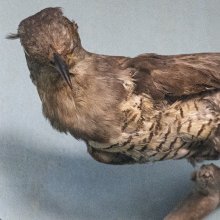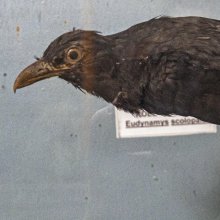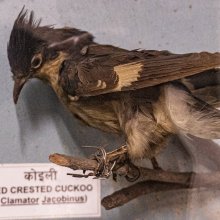Cuckoo: 3 definitions
Introduction:
Cuckoo means something in Buddhism, Pali, Hinduism, Sanskrit. If you want to know the exact meaning, history, etymology or English translation of this term then check out the descriptions on this page. Add your comment or reference to a book if you want to contribute to this summary article.
Images (photo gallery)
In Hinduism
Natyashastra (theatrics and dramaturgy)
Source: Shodhganga: Elements of Art and Architecture in the Trtiyakhanda of the Visnudharmottarapurana (natya)The Cuckoo (animal) is associated with Bhramara-hasta: one of the twenty-two Single-hand Gestures (in Indian Dramas) (known as asaṃyuktahastas), according to the Viṣṇudharmottarapurāṇa, an ancient Sanskrit text which (being encyclopedic in nature) deals with a variety of cultural topics such as arts, architecture, music, grammar and astronomy.—The name of the posture bhramara itself identifies the shape of a bhramara i.e., a black bee. Abhinavagupta also admits it. [...] In the Abhinayadarpaṇa, this posture is said to denote bee, parrot, wing, crane, cuckoo etc.

Natyashastra (नाट्यशास्त्र, nāṭyaśāstra) refers to both the ancient Indian tradition (shastra) of performing arts, (natya—theatrics, drama, dance, music), as well as the name of a Sanskrit work dealing with these subjects. It also teaches the rules for composing Dramatic plays (nataka), construction and performance of Theater, and Poetic works (kavya).
Shilpashastra (iconography)
Source: Shodhganga: Elements of Art and Architecture in the Trtiyakhanda of the Visnudharmottarapurana (shilpa)The Cuckoo is associated with the Spring season, which follows specific guidelines of ancient Indian Painting (citra), according to the Viṣṇudharmottarapurāṇa, an ancient Sanskrit text which (being encyclopedic in nature) deals with a variety of cultural topics such as arts, architecture, music, grammar and astronomy.—In the Viṣṇudharmottarapurāṇa, the rules of Painting of different classes have been elaborately discussed. The picture of Vasanta i.e., the spring season should contain the trees which bloom in this season particularly the cuckoo, honey bees and joyful men and women. Thus the picture reciprocates the natural actions that generally happen in life. In the Sivapurāṇa, a beautiful picturisation of the Spring season is found where the spring season is described with abundance of flowers, blossoms, fragrant wind, cuckoo’s song, clean lakes, blooming lotuses etc.

Shilpashastra (शिल्पशास्त्र, śilpaśāstra) represents the ancient Indian science (shastra) of creative arts (shilpa) such as sculpture, iconography and painting. Closely related to Vastushastra (architecture), they often share the same literature.
In Buddhism
Tibetan Buddhism (Vajrayana or tantric Buddhism)
Source: academia.edu: The Structure and Meanings of the Heruka MaṇḍalaThe Cuckoo (animal) is associated with the Yoginī (female deity) named Sāmā or Śyāmā, being situated in the Vāyucakra, according to the 10th century Ḍākārṇava-tantra: one of the last Tibetan Tantric scriptures belonging to the Buddhist Saṃvara tradition consisting of 51 chapters.—Accordingly, the vāyucakra refers to one of the three divisions of the dharma-puṭa (‘dharma layer’), situated in the Herukamaṇḍala. The 36 pairs of Ḍākinīs [viz., Sāmā or Śyāmā—“Cuckoo”] and Vīras are dark blue in color; they each have one face and four arms; they hold a skull bowl, a skull staff, a small drum, and a knife.

Tibetan Buddhism includes schools such as Nyingma, Kadampa, Kagyu and Gelug. Their primary canon of literature is divided in two broad categories: The Kangyur, which consists of Buddha’s words, and the Tengyur, which includes commentaries from various sources. Esotericism and tantra techniques (vajrayāna) are collected indepently.
See also (Relevant definitions)
Starts with: Cuckoo pint, Cuckoo plant, Cuckoo-button, Cuckoopint.
Full-text (+270): Kokila, Pika, Anyapushta, Parapushta, Vasantaduta, Ghoshayitnu, Madhughosha, Pumskokila, Tamraksha, Kuhu, Kalarava, Ravatha, Dhvankshapushta, Madhusvara, Acalatvish, Kinkira, Koka, Poshayitnu, Kalakanthin, Vasantaghoshin.
Relevant text
Search found 100 books and stories containing Cuckoo; (plurals include: Cuckoos). You can also click to the full overview containing English textual excerpts. Below are direct links for the most relevant articles:
Animal Kingdom (Tiryak) in Epics (by Saranya P.S)
Chapter 4.28 - The Kokila (Koel) in the Epics
Chapter 4.20 - Animals and birds in the epic Ramayana (Introduction)
Chapter 4.22 - The Cataka (Pied crested cuckoo) in the Epics
Sahitya-kaumudi by Baladeva Vidyabhushana (by Gaurapada Dāsa)
Text 10.202 < [Chapter 10 - Ornaments of Meaning]
Text 10.129 < [Chapter 10 - Ornaments of Meaning]
Text 4.90 < [Chapter 4 - First-rate Poetry]
Garga Samhita (English) (by Danavir Goswami)
Verses 2.17.15-17 < [Chapter 17 - The Meeting of Śrī Rādhā-Kṛṣṇa]
Verse 2.9.20 < [Chapter 9 - Brahmā’s Prayers]
Verse 2.25.11 < [Chapter 25 - The Rāsa-dance Pastime]
Kavyamimamsa of Rajasekhara (Study) (by Debabrata Barai)
Part 7.7 - Poetic conventions regarding to the Birds < [Chapter 5 - Analyasis and Interpretations of the Kāvyamīmāṃsā]
Part 8.11 - Characteristics of Hementa-kāla (dewy season) < [Chapter 5 - Analyasis and Interpretations of the Kāvyamīmāṃsā]
Part 8.13 - Characteristics of Vasanta-kāla (spring season) < [Chapter 5 - Analyasis and Interpretations of the Kāvyamīmāṃsā]
Trishashti Shalaka Purusha Caritra (by Helen M. Johnson)
Part 7: Mahāvīra’s ten visions < [Chapter III - Mahāvīra’s first six years as an ascetic]
Part 15: Story of disputed parentage < [Chapter III - Sumatināthacaritra]
Part 3: Description of Aṣṭāpada < [Chapter VI]
The Agni Purana (by N. Gangadharan)
Related products




